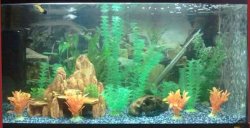Agree with Gilli and the others, dark green leaf color is a tip that you are likely looking at a plant that falls into the category of "easy" or "low-light" plant that will not need high lighting and CO2 supplementation to support.
We use various rough guidelines to help guide people in this "low-light technique" direction (hopefully this being a concious choice on their part and to me it sounds like this is the right direction for you as you've not mentioned wanting to look into serious CO2 equipment or such) and light and plant nutrition are key among them. I suspect that a tank receiving water changes with high pH water (probably hard water) will probably do quite well with plants as it implies that there are probably healthy amounts of calcium, magnesium and other trace things in the water that the plants can use to their benefit.
When you find the wattage on your tube you will also want to note the diameter of the tube. Most traditional tubes are perhaps an inch and we call that a "T8" type of fluorescent light. The efficiency of conversion of electricity to light is well known for a T8 and allows us to use wattage as a way to judge how much light the plants will receive from the tube. If a tube stays roughly below the 2 watt/USgallon level but above about 0.80 w/g then we know the provided T8 light will put us "in range" for low-light technique.
In low-light technique we rely on the fish food or possibly a tiny bit of plant nutrition supplementation to provide many of the essential macro and micro nutrients that plants need to be successful. We sometimes decide to provide some daily liquid carbon because carbon is such a key nutrient that it is in a category by itself compared to the others (plants use up lots and lots of carbon making sugar so that energy can be transported throughout the plant and lack of sufficient carbon is among the most common things that cause plants to not make it.) The nice active surface water movement that we like to use to provide higher oxygen for our freshwater fish also tends to drive a little more CO2 out of the tank, thus working against our plants a little. So liquid carbon (a type of product we dose the tank with) can help to reverse that problem a little.
If we find that our light is up above the 2 watt/USgallon level then know that we are "driving" the plant process at a higher rate and the typical non-supplemented tank will use up all its nutrients too quickly for the plants to thrive. (Again, all this talk of 2watts changes if our tubes are T5 type and therefor more efficient and giving off much more light.) For our members who happen to be in the UK, there is the luck of being able to get a wonderful mix of plant nutrients in a product called TPN+ (the Plus part being important) which in a low-light tank can be dosed in tiny amounts and then thinned out with the weekly water change. This is a method called "reduced EI" (EI is discussed in the planted tank (PARC) articles.)
Anyway, just throwing out stuff to help you get started, no need to understand it all at this point as having live plants can be exceedingly easy and I always encourage people to get started with it and gain experience!
~~waterdrop~~




